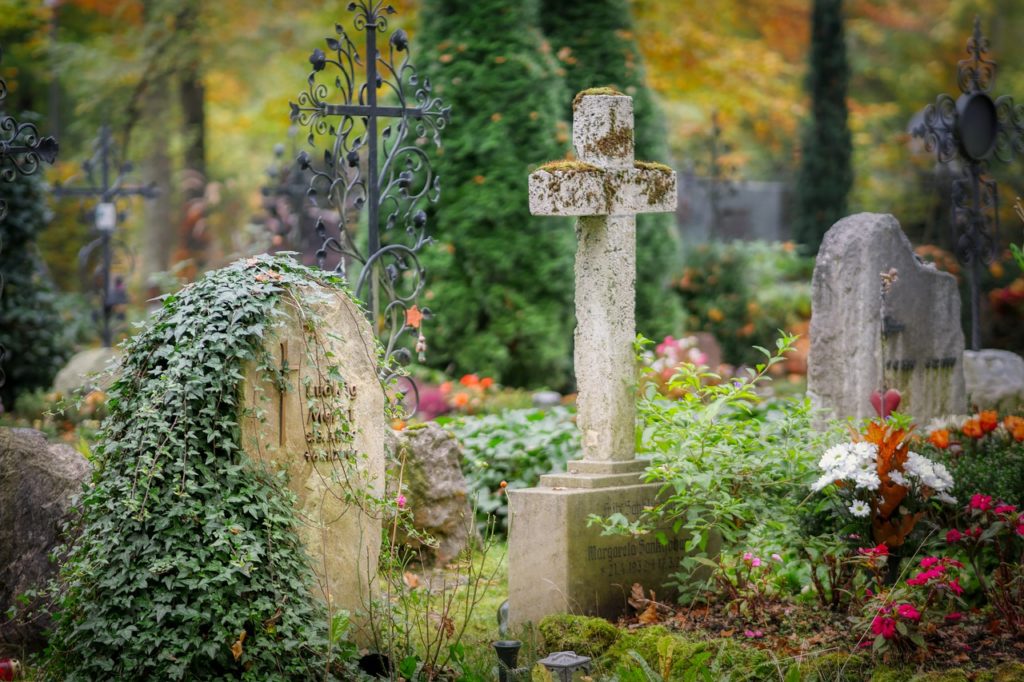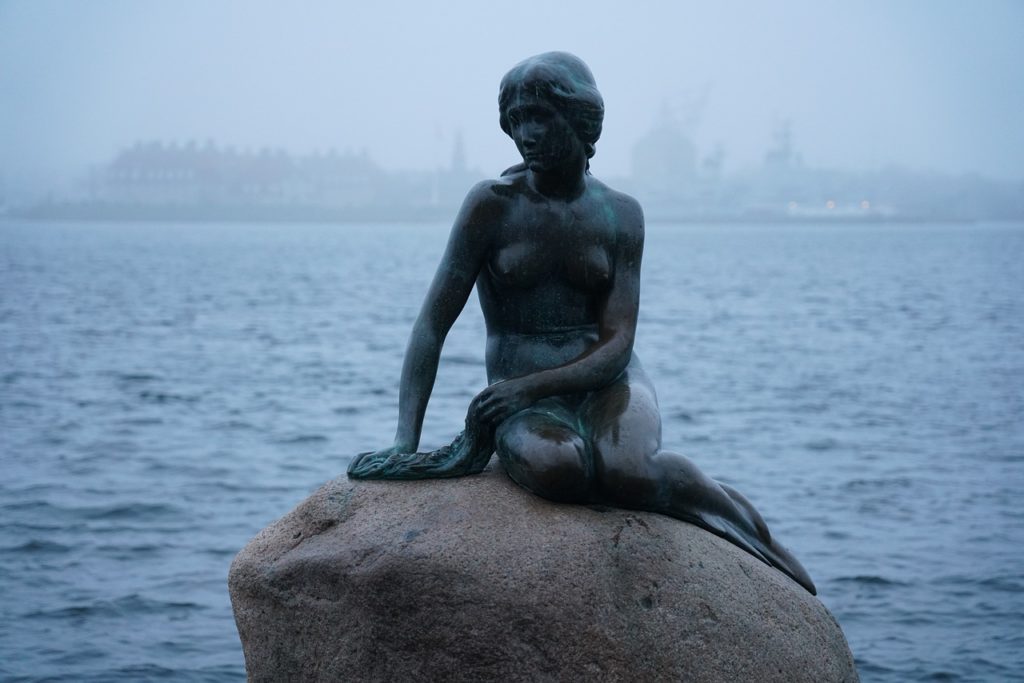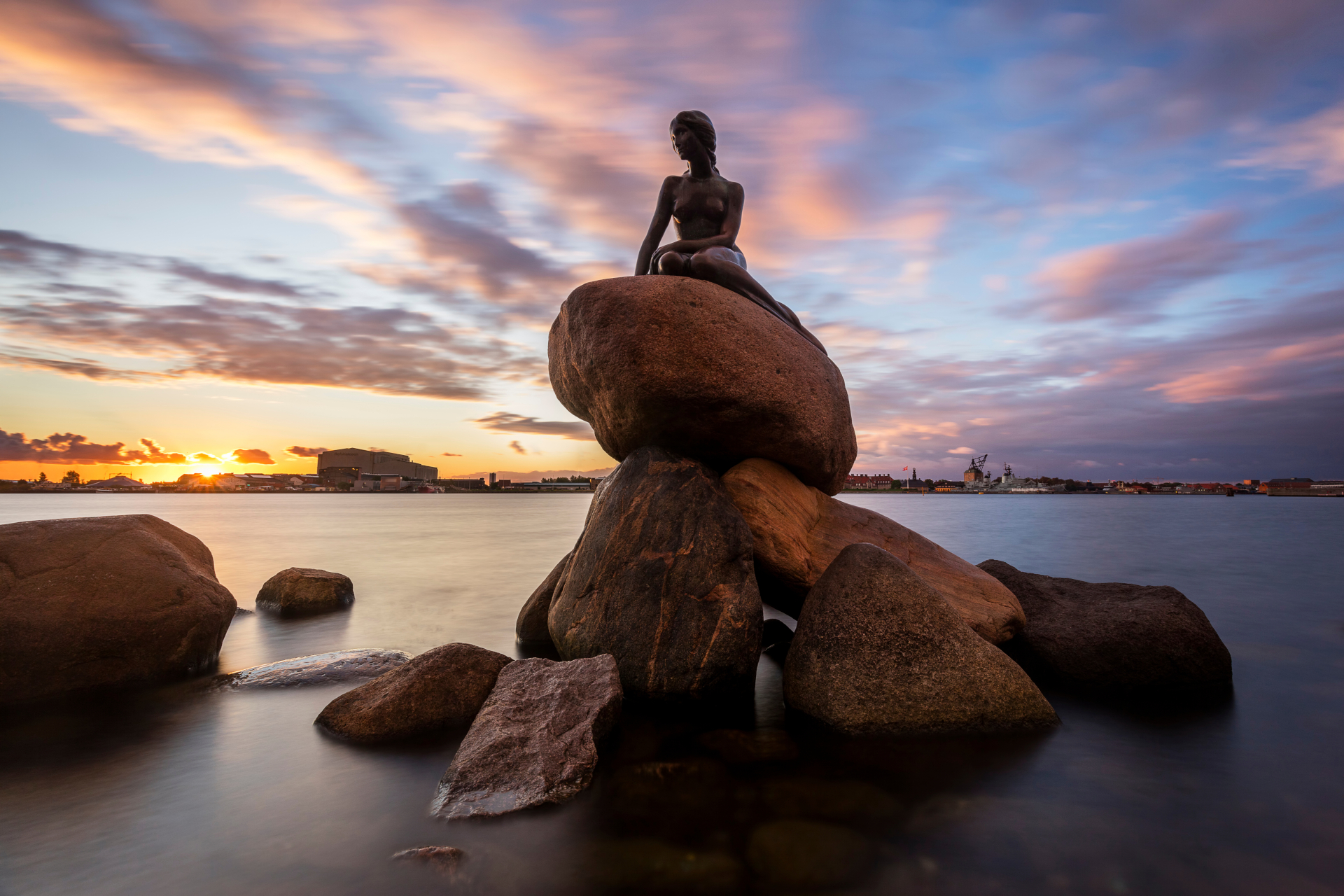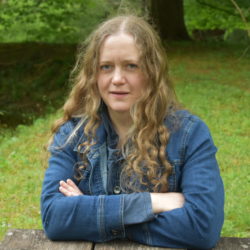My grandmother relished the first full sentence I addressed to her: “You stop it, Grandma, you stop it!” The reason for my toddler objection to her behavior is lost to my memory. While it was the first time I protested some action of hers, it certainly wouldn’t be the last.
At the age of seven, I accompanied Grandma to a local cemetery. In northern Minnesota where I was born, previous residents had hacked rough graveyards from an even rougher wilderness, the same forests where we heard wolves howl in the distance on winter nights. This particular cemetery had a couple children’s tombstones with lambs on them—the ones people all over the country used to order from Sears & Roebuck. When we arrived, I immediately went to visit the lambs and ponder the grim reality that these poor children had been even younger than I was when they died.
A dreadful wailing rose behind me. I froze for an instant, convinced a ghost had made the sound. As I turned, I saw my grandmother kneeling on a small gravestone, sunk in the earth, and weeping with violent abandon. I approached her slowly, not sure what to do. Her upset scared me. When you’re seven, the last thing you want is your caretaker showing signs of instability, especially when there are no other adults around to take charge and you’re miles from real civilization. Also, I felt bad for her. Why was she so sad, so suddenly?

I touched her shaking shoulder and asked her what was wrong. In jerky sobs, she told me the grave belonged to my uncle, my mother’s older brother. She said he had died at age nineteen of a brain aneurysm. After what seemed like an hour, she calmed down a bit, then said that it was probably a blessing that he had died, since he likely would have been permanently disabled.
My young mind couldn’t quite grasp all of this. The facts seemed clear enough, but that strange word—aneurysm—kept tripping me up. There was also just the unfathomable immensity of such a tragedy. I came away longing to learn more about this mysterious uncle and wistful that I hadn’t known him—feelings that still haunt me to this day.
When I got home, I told my mother what had happened in the graveyard. She went silent for awhile, her gaze far off. Then she looked at me, and I saw her eyes glistening with unshed tears. She sighed and hugged me against her. Later, Mom told me that my uncle had actually killed himself, but that Grandma couldn’t handle the reality of his suicide, so we had to let her keep her illusions intact. My young mind understood this on a concrete level: it was like protecting smaller kids from knowing the truth about Santa Claus. We all need certain illusions to get through life, some of us more so than others.
Mom told me that my uncle had actually killed himself, but that Grandma couldn’t handle the reality of his suicide, so we had to let her keep her illusions intact.
Mom told me something else, too: my grandmother had enacted an almost identical scene in the graveyard with my brother when he was six or seven. This dramatic repetition has fascinated me ever since. Why did she feel compelled to do it in front of her young grandchildren? Did she ever go up to the graveyard and do the same thing when she didn’t have an audience? I doubt it. I don’t question the sincerity of her grief, theatrical as it was; we all sometimes want a witness to our emotional states, a companion to share the load with us.
Grandma, however, needed such witnesses all the time. I have often wondered if narcissists perhaps need to see their pain or joy reflected in those around them in order to experience it at all in some vicarious way. Those of us in a narcissist’s orbit sometimes sense we are little better than mirrors to them, there to be an audience to their emotions but not allowed to feel any of our own.
Those of us in a narcissist’s orbit sometimes sense we are little better than mirrors to them, there to be an audience to their emotions but not allowed to feel any of our own.
The Confidence to Stand Firm
Grandma made for a mean parent. When my mother married my father, Grandma said to her, “If I were twenty years younger, you wouldn’t have a chance with him.” What kind of mother says such a thing to her daughter?
A narcissist, that’s what kind.
As a grandmother, at least, she had her kinder moments. She sewed dolls for me, took me for picnics beside the lake, and played endless hours of “Go Fish” with me. I loved her and eventually felt quite sorry for her as I comprehended how miserable she made herself. I also had the luxury of not putting up with her small-minded tyranny because my parents had no blinders on when it came to her.
Every child could use at least one properly-explained narcissist in his or her life. It would help us delineate boundaries better as adults. My grandmother taught me many important lessons about boundaries, but only because my mother and father explained her peculiar behavior to me in a way I could understand and supported my rebellions against her ridiculous demands.
For instance, soon after the graveyard incident, Grandma gave me a cameo pin. A few months later, she saw me putting it on my favorite doll. My grandmother said she wanted the pin back. I told her no, that it had been a gift, and I didn’t return gifts. She threatened never to speak to me again. I said fine, but she wasn’t getting the pin back. For the rest of that summer, the only interaction I had with her was when she called, crying loudly into the phone, and told me what a mean and awful granddaughter I was for not granting her simple request. I continued to refuse. Even then, I had a ruthless sense of fair play.
Finally, my mother intervened. She explained that she was proud of me for holding my ground and that my grandmother was in the wrong. However, in the interest of family peace, would I consider returning the pin? I thought about it and conceded the issue, realizing it was a small battle in a much larger war. I understood then that I couldn’t reason with my grandmother, that there are some people in this world that can’t be reasoned with, and if I wanted to get anywhere with such people that I would need to strategies more subtle than simply digging my heels in to defend against their manipulations.
One of those strategies—the most necessary—is retaining productive self-awareness. I knew I wasn’t being a cruel child when I refused to return the pin. I knew this because my parents had allowed me to be my own individual. Even so, all my empathy screamed at me that summer whenever my grandmother called, crying and trying to twist the situation to put herself in the right and me in the wrong. Empathy is a good impulse—it helps me be a better friend and understand my characters when I write. However, empathy in response to my grandmother’s attempts at manipulation would have enabled her bad behavior and left me feeling irrational guilt for something that wasn’t my fault.
Empathy in response to my grandmother’s attempts at manipulation would have enabled her bad behavior and left me feeling irrational guilt for something that wasn’t my fault.
How We Confuse Children
This works on a societal level as well—and as a society, we’re going in the wrong direction. I’m so glad I grew up when I did, with the parents I had. I had some serious ordeals as a child—my grandmother’s antics were the least of these—and without my parents, I wouldn’t have made it. They understood the sacred boundaries of childhood and their role in maintaining the same, and they imparted that knowledge to me, so that when others violated those boundaries, I could clearly see it.
The messages today’s children receive are far less clear. We simultaneously over-protect and under-protect childhood, without regard to its role in healthy human development.
A few months ago, a friend and I chatted about her daughter’s evolving interest in fantasy stories. I mentioned “The Little Mermaid,” my best beloved fairy tale as a child. My friend frowned and said, “My daughter didn’t like the ending of that one.”
“Really?” I exclaimed. When I went on to describe the rewards of the mermaid’s selfless love and sacrifice, my friend’s frown deepened. “That’s not the same ending as the story we read,” she said. She retrieved the book, and we looked at it together. When I read the revised ending of Andersen’s mermaid tale, I sighed. Some modern-day busybody had bowdlerized it and drained it of all its emotional power. No wonder my friend’s daughter disliked it.
When I first heard “The Little Mermaid” as a child, it was the original English translation of the Hans Christian Andersen story. The Disney version wouldn’t come out until a few years later. I fell in love with the fairy tale and the idea of merpeople living under the sea. Even when he wrote happy endings such as in “The Snow Queen,” Andersen captured the sense of a magical world long since lost, a wistful place rife with the complexity of adult emotions acting on a childhood stage.
From a young age, I identified with Andersen’s heroes, particularly the little mermaid. She represents the dreamy outsider; she longs for a human life above the waves, and her yearning sets her apart from her family and other merpeople. In the movie, this conflict is larger than life, with dramatic arguments and loud rebellion. The written story takes a subtler approach, with the little mermaid slowly drifting away from others of her kind and towards the human world above.

The Flattening of Our Emotional World
Children, especially those who suffer some intense sorrow that sets them apart from their peers, need stories such as Andersen’s “The Little Mermaid.” In all three versions of the story, the mermaid falls in love with a human prince and sacrifices her voice to the sea witch in order to turn her fins into legs. As part of her deal with the sea witch, the mermaid must get the prince to love her in return, or she will dissolve into sea foam.
Here is where the Disney version departs from the other two. In the written story, merpeople live for hundreds of years but have no souls, so death is the utter end for them rather than a transition to the afterlife. Disney never gets into this metaphysical conundrum, instead concentrating on the love story and the sea witch’s vendetta against King Triton.
Andersen’s story and its pale modern counterpart state that if the mermaid earns the prince’s love, then she will gain a human soul. She goes to the prince’s palace and tries to woo him without her voice. Alas, although he grows fond of the little mermaid, he falls in love with another woman and marries her instead.
Devastated, the mermaid awaits her death on the deck of the wedding ship. Then her sisters emerge from the ocean with a seeming reprieve—they have gone to the sea witch and exchanged their hair for a magic dagger. If the little mermaid uses this dagger to slay the prince, she won’t dissolve into sea foam. Instead, she can return to her former life under the waves.
At her sisters’ urging, she takes the dagger, but when she gazes upon the sleeping prince and his bride, she cannot bring herself to harm him. She flings the dagger out into the sea and slips into the water, prepared to die rather than kill the one she loves, even though he doesn’t love her in return.
Missing the Daughters of the Air
In Andersen’s original tale, the daughters of the air show up at the moment of the mermaid’s death. They praise her for her selfless sacrifice and willingness to do the right thing, even though she knew it would cost her not just her life, but her very existence. The daughters of the air ask her to join them and go about the world performing good works; in such work, she can forge her own immortal soul rather than depend on a human’s love to grant her one. She goes with the daughters of the air into her new life, and the story ends on an uplifting note. Even though she doesn’t get the prince and the happily ever after she wanted, she gains an eternal joy and a mission beyond mere happiness, a theme children and adults who have endured tragedy can appreciate.
Even though she doesn’t get the prince and the happily ever after she wanted, she gains an eternal joy and a mission beyond mere happiness, a theme children and adults who have endured tragedy can appreciate.
The abridged version that my friend’s daughter read strips this ending of its meaning and power. The daughters of the air never appear—they’ve been edited out entirely. Instead, the mermaid drifts into the sky, utterly alone. She has no way to earn a soul; rather there is some vague mention of her goodness living on in the light on the waves, and that’s it.
What saddens me most is that I suspect whoever rewrote “The Little Mermaid” for modern audiences doesn’t understand the vast difference between his or her ending and the original. The edition with the newer version contains lovely paintings, so it’s not a complete loss. However, what the editors never clarify is that they have abridged and simplified Andersen’s stories and hence ruined at least one of them for this reader. I haven’t had the heart to read the other tales in the abridged book; instead I bought the illustrated classic collection, which contains the original English translation of Andersen’s words.
Why the editors chose to change Andersen’s stories remains a mystery. Did they think that today’s children wouldn’t comprehend the nineteenth century vocabulary and phrasing of the older translation? Were they trying to make more space for the illustrations? Did the recurring theme of sacrifice for the sake of love and references to Christianity bother them? If so, they could have cut out words pertaining to a specific religion without taking away the mermaid’s chance for a soul. Whatever their reasoning, I wish they hadn’t engaged in false advertising: my friend assumed that what she read to her daughter were Andersen’s original stories because nothing in the book indicates otherwise.
The Power of Emotional Honesty
If Grandma’s narcissism taught me about healthy boundaries, then tales such as Andersen’s “The Little Mermaid” taught me about the power of emotional honesty in storytelling. And these two lessons go hand in hand: they are the areas in which our modern society needs to reverse course if we are going to guide children to become healthy, well-adjusted adults.
This may even be doubly important for the intellectually inclined, deeply feeling sorts of people who read this magazine. For all people, but perhaps especially these people, stories that tell complete emotional truths in all their complexity fulfill the highest purpose of childhood fantasy play. Rehearsing an emotionally flat world in your imagination doesn’t prepare you for much, after all.
Moreover, to function in that emotionally complex world, we need to be able to test—and eventually come to trust—our instincts about when we’re in the right. This is part of setting those boundaries that are essential to our thriving. The evocative truth and depth of stories like “The Little Mermaid” inoculate us to some degree against attempts to manipulate our emotions. When we truly know and respect ourselves, we become the sort of healthy nonconformists who don’t need to mindlessly follow the herd in order to feel secure.




